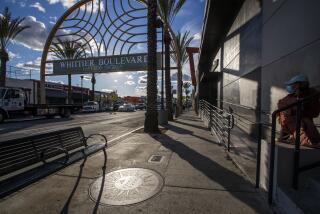Dallas’ southern half considers breaking away : Poor part of town seeks improved services. Proposed secession would cut the population by a third.
- Share via
DALLAS — The talk these days in Oak Cliff is about secession.
As in secession from Dallas. As in taking away a third of the population and half the land mass of the city.
This is serious business. If the residents of Oak Cliff, which makes up the shop-worn southern half of the city, go through with this, Dallas would sink from second to third in the ranks of the state’s most populous cities. Oak Cliff would immediately become the seventh-largest city in Texas.
What city officials saw as little more than a publicity stunt a few months ago is now being taken very seriously indeed.
The backers of the secession movement contend that Oak Cliff has been treated like a second-class citizen while the more affluent northern half of the city has been dealt all the perks, from better parks and libraries to sewer system repairs. A contributing factor is the feeling that Oak Cliff, whose population is about evenly divided among whites, blacks and Latinos, has not been properly represented on the Dallas City Council.
So intense is the resentment in this declining section of the city that Mayor Annette Strauss was shouted down by a crowd of 1,700 people last month when they gathered to decide whether to continue the secession movement in earnest.
“We are one family,” she said. “That’s the way it’s been and that’s the way it’s got to continue to be.”
The citizens of Oak Cliff, who voted overwhelmingly to look seriously at the secession possibility, are not so sure.
“Nobody (in the Dallas hierarchy) took it seriously,” said Bob McElearney, the president of the Oak Cliff Chamber of Commerce and one of the leaders in the secession movement. “Now I go to meetings and I hear people say, ‘You can’t do this to Dallas.’ ”
McElearney, who contends that Oak Cliff could make it on its own, said the incident that led to the serious discussion of secession was the City Council’s balking at a voter-approved measure that would have given the southern half of the city more council seats. It was, said McElearney, “the straw that broke the camel’s back.”
Dr. Charles Tandy, the lone city councilman representing Oak Cliff, said the talk of bidding Dallas goodby first took place at clandestine meetings. But as time went on, word began to spread. At the first public meeting, 450 people showed up. At the next, there were 900. Then came the meeting in which the mayor was shouted down.
Not that deannexation is going to be all that easy. The secession movement is strongly opposed by the leaders of some of the city’s most powerful black religious and union organizations. And there are people within the community who are not convinced that leaving Dallas would be a panacea for all the ills of Oak Cliff, which has a population of 373,000 and an area of more than 200 square miles.
“I don’t know yet how I would vote,” said Ron Hurt, who fears the deterioration of an already-struggling school system.
At a recent meeting, former City Councilman Jerry Gilmore pleaded with citizens not to rush headlong into secession, arguing that Dallas was like most major cities in the country today--long on problems but short on cash.
“Dallas has real problems, but dividing our resources is not the way to solve those problems,” he said. “I’m saying secession is a dangerous movement.”
Perhaps, but the movement is obviously gaining momentum. Organizers have created 19 committees consisting of 130 people to study the various facets of a breakaway from Dallas. McElearney said that Dallas’ response to Oak Cliff’s needs had already improved since the secession movement began building up steam. But he also insisted that talk of leaving Dallas was not just a ploy to force the city to take notice of its southern half.
“This is not a game,” he said. “We are committed to going through with the process. That keeps us on an even playing field.”
The plan at the moment is to put the matter before the voters in 1992. But it will not be easy. One method of deannexation calls for a citywide vote. Another has to work its way through the state Legislature.
Tandy, the Oak Cliff councilman who is also an anesthesiologist, remained optimistic that his district eventually would benefit from the row going on now.
“People know where Oak Cliff is now,” he said. “No matter what happens, this community is going to win.”
More to Read
Get the L.A. Times Politics newsletter
Deeply reported insights into legislation, politics and policy from Sacramento, Washington and beyond. In your inbox three times per week.
You may occasionally receive promotional content from the Los Angeles Times.










